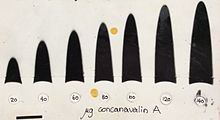
Affinity electrophoresis is a general name for many analytical methods used in biochemistry and biotechnology. Both qualitative and quantitative information may be obtained through affinity electrophoresis.[1] Cross electrophoresis, the first affinity electrophoresis method, was created by Nakamura et al. Enzyme-substrate complexes have been detected using cross electrophoresis.[2][3][4][5][6] The methods include the so-called electrophoretic mobility shift assay, charge shift electrophoresis and affinity capillary electrophoresis.[1] The methods are based on changes in the electrophoretic pattern of molecules (mainly macromolecules) through biospecific interaction or complex formation. The interaction or binding of a molecule, charged or uncharged, will normally change the electrophoretic properties of a molecule.[7][1] Membrane proteins may be identified by a shift in mobility induced by a charged detergent. Nucleic acids or nucleic acid fragments may be characterized by their affinity to other molecules. The methods have been used for estimation of binding constants, as for instance in lectin affinity electrophoresis or characterization of molecules with specific features like glycan content or ligand binding.[1] For enzymes and other ligand-binding proteins, one-dimensional electrophoresis similar to counter electrophoresis or to "rocket immunoelectrophoresis", affinity electrophoresis may be used as an alternative quantification of the protein.[8] Some of the methods are similar to affinity chromatography by use of immobilized ligands.
- ^ a b c d Kinoshita, Eiji; Kinoshita-Kikuta, Emiko; Koike, Tohru (2015-03-18). "The Cutting Edge of Affinity Electrophoresis Technology". Proteomes. 3 (1): 42–55. doi:10.3390/proteomes3010042. ISSN 2227-7382. PMC 5302491. PMID 28248262.
- ^ Nakamura, S.; Takeo, K.; Sasaki, I.; Murata, M. (August 1959). "Proof of the Formation of Enzyme-Substrate Complex by 'Crossing-Paper Electrophoresis'". Nature. 184 (4686): 638–639. Bibcode:1959Natur.184..638N. doi:10.1038/184638a0. ISSN 0028-0836. PMID 14425900. S2CID 4215250.
- ^ Nakamura, S.; Takeo, K.; Sasaki, I. (January 1962). "Nachweis von Enzym-Substrat-Komplexen durch Kreuzungselektrophorese". Hoppe-Seyler's Zeitschrift für physiologische Chemie. 328 (Jahresband): 139–144. doi:10.1515/bchm2.1962.328.1.139. ISSN 0018-4888. PMID 14478156.
- ^ Nakamura, Shojiro; Takeo, Kazusuke; Sasaki, Iwane (January 1963). "Nachweis von Enzym-Substrat-Komplexen bei inaktiven oder inaktivierten Enzymen". Hoppe-Seyler's Zeitschrift für physiologische Chemie. 334 (Jahresband): 95–102. doi:10.1515/bchm2.1963.334.1.95. ISSN 0018-4888. PMID 14136727.
- ^ Takeo, Kazusuke; Nakamura, Shojiro (November 1972). "Dissociation constants of glucan phosphorylases of rabbit tissues studied by polyacrylamide gel disc electrophoresis". Archives of Biochemistry and Biophysics. 153 (1): 1–7. doi:10.1016/0003-9861(72)90413-4. PMID 4119570.
- ^ Takeo, Kazusuke; Nitta, Kazuko; Nakamura, Shojiro (November 1974). "Demonstration of phosphorylase in urines by polyacrylamide gel disc electrophoresis". Clinica Chimica Acta. 57 (1): 45–54. doi:10.1016/0009-8981(74)90176-4. PMID 4430142.
- ^ Aizpurua-Olaizola, Oier; Sastre Torano, Javier; Pukin, Aliaksei; Fu, Ou; Boons, Geert Jan; de Jong, Gerhardus J.; Pieters, Roland J. (January 2018). "Affinity capillary electrophoresis for the assessment of binding affinity of carbohydrate-based cholera toxin inhibitors". Electrophoresis. 39 (2): 344–347. doi:10.1002/elps.201700207. hdl:1874/362143. PMID 28905402. S2CID 33657660.
- ^ Deeb, Sami El; Wätzig, Hermann; El-Hady, Deia Abd (July 2013). "Capillary electrophoresis to investigate biopharmaceuticals and pharmaceutically-relevant binding properties". TrAC Trends in Analytical Chemistry. 48: 112–131. doi:10.1016/j.trac.2013.04.005.